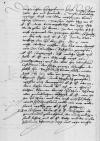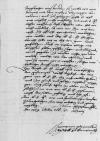Letter #5204
Ioannes DANTISCUS to Albrecht I von Hohenzollern-AnsbachHeilsberg (Lidzbark Warmiński), 1538-10-29
| received Königsberg (Królewiec), 1538-10-31 Manuscript sources:
Auxiliary sources:
Prints:
| ||||||||
Text & apparatus & commentary Plain text Text & commentary Text & apparatus
 GStA, PK, HBA, C 1, No 533, f. 3 unnumbered
GStA, PK, HBA, C 1, No 533, f. 3 unnumbered
Dem durchlauchten, hochgebornen(n) fursten und hern, hern
 GStA, PK, HBA, C 1, No 533, f. 1 unnumbered
GStA, PK, HBA, C 1, No 533, f. 1 unnumbered
Durchlauchter, hochgeborner furst, hochgunstiger, lÿber her und freundt. / Unser freuntliche, wÿllige dinst mit aller wÿlferiger erbiethung zuvoran. /
Uns sein dÿsen thag von E(wer) F(urstlichen) D(urchlauch)t dreÿ brive, ungeferlich den XXVI dÿts monts geben, zu komen, / in dem cf.
Im andren cf.  GStA, PK, HBA, C 1, No 533, f. 2 unnumbered dergleychen vorstanden, / so wolle wir uns dennoch mit den unsern derwegen beredenn / und zu gelegner zeÿtt, so vÿl uns muglich, nicht misfellig antwurt E(wer) D(urchlauch)t lassen wÿssen etc. Dass schÿssen aber hab wir auch muntlich, / do wir von den unsern negst dÿ pflicht eynnhomen(n), / vorbothen. / Wir wolten wol, das E(wer) F(urstliche) D(urchlauch)t rechten bericht hette, wÿ es beÿ den ÿren wirt gehalthen, / dass dÿ unsern etliche mit buchssen(n) solten geshen seÿn, / und solch antwurt gegeben, / sy wusten nichts von dem vorboth, / wolthe wir der nhamen(n) / und wer sy weren gerne wÿssen, / solthen irer byllicher straff nicht entghen[2] etc.
GStA, PK, HBA, C 1, No 533, f. 2 unnumbered dergleychen vorstanden, / so wolle wir uns dennoch mit den unsern derwegen beredenn / und zu gelegner zeÿtt, so vÿl uns muglich, nicht misfellig antwurt E(wer) D(urchlauch)t lassen wÿssen etc. Dass schÿssen aber hab wir auch muntlich, / do wir von den unsern negst dÿ pflicht eynnhomen(n), / vorbothen. / Wir wolten wol, das E(wer) F(urstliche) D(urchlauch)t rechten bericht hette, wÿ es beÿ den ÿren wirt gehalthen, / dass dÿ unsern etliche mit buchssen(n) solten geshen seÿn, / und solch antwurt gegeben, / sy wusten nichts von dem vorboth, / wolthe wir der nhamen(n) / und wer sy weren gerne wÿssen, / solthen irer byllicher straff nicht entghen[2] etc.
Der drÿtt E(wer) D(urchlauch)t cf.
Datum


